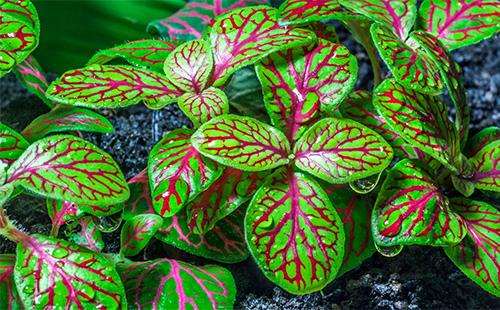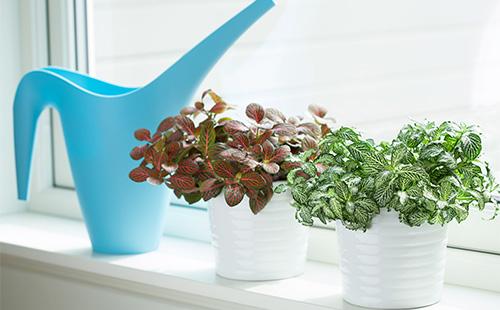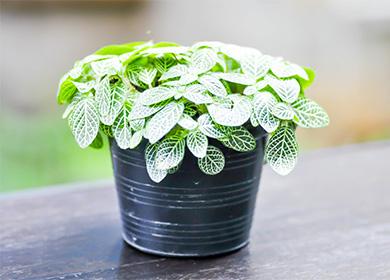The content of the article
Beauty Fittonia is a bright representative of the acanthus family. However, this is unlikely to say anything about a homegrown grower. Creeping houseplant can be recognized by medium-sized leaves with clearly defined and pronounced veins of different colors.
Reviews of experts say that fittonia, having a large sheet plate, is absolutely not adapted for life in urban apartments and country houses. You can grow a large flower of the acanthus family, perhaps by organizing in your own house a paludarium, a florarium or the so-called bottle garden. If you don’t have the opportunity to create a miniature home greenhouse, but you still want to enjoy the fittonia, it is better to choose a variety with small leaves.
Kinds
There are only 15 species of Fittonia. Compared to other indoor plants, the genus of this flower is very modest and not numerous. The table shows the most popular types of moody beauty and lists the characteristics of each of them.
Table - Popular "domesticated" types of Fittonia
| View name | Specifications |
|---|---|
| White-streaked or Silver-veined | - Miniature erect bush; - oval-shaped sheet plate; - silver streaks |
| Giant | - Erect tall bush; - red veins on a leaf plate; - large leaves of dark green color |
| Vershaffelt | - Creeping plant; - veins of white color |
Before embarking on the cultivation of Fittonia, you should be interested in the peculiarities of the breeding of various species and varieties of this indoor flower. For example, the Giant and Vershaffelt species are completely unable to survive in the home. It’s worth acquiring these flowers only if you intend to organize a mini-greenhouse in the apartment. Silver-veined fittonia is also not too willing to take root on the windowsill. But it does it all the same much better than the two previous types.
Fittonia care at home: the basic principles of growing whims
It is warm and very humid. It is these conditions that a native of Fittonia loves. For this reason, growing a plant at home is very difficult. But for a true amateur florist, nothing is impossible.
Where to put
The answer to the question of how to care for fittonia begins with a competent determination of its location in the house. The window sills of windows facing the West and the East are considered the best option for placing a flower. After breeding the plant and obtaining "offspring" at home, the "children" can be planted even on the northern windowsills. But such a location is not suitable for a pioneer flower.
How much light to give
Direct sunlight is unacceptable for South American handsome. But lack of light is also bad. If you put a pot of fittonia in a darkened place or deep into a poorly lit room, the plant will immediately begin to wither. Lack of lighting is a common cause of pallor of a leaf plate and subsequent leaf fall.
How not to freeze and not overheat
With temperature differences and drafts, Fittonia also has an unimportant relationship. Both phenomena can destroy the flower. Therefore, do not try to take out a pot of beauty to the street or balcony in the summer. Do not put a flower pot in front of an open window - he terribly does not like it. Just a couple of weeks of exposure to drafts or temperature jumps - and the plant will no longer be saved.
But the most difficult thing is not even that. Surviving the winter with Fittonia is really hard. A flower with paper leaves loves the heat. If the central heating in your house works with a bang, it will only be on hand. But if the house is cool, get ready to say goodbye to the flower. Lowering the temperature below 17 ° C for a long time will destroy it, and you are unlikely to be able to somehow influence it.
What humidity to provide
A feature of the plant under discussion is high transpiration. This intricate term means that Fittonia is more prone to moisture evaporation through a sheet plate. So, this indoor plant should be moistened more often than its neighbors on the windowsill. In order not to overmoisten the flower and not to overdry it, use a household humidifier. When growing Fittonia in a paludarium, make sure that the moisture does not stagnate.
How to water
Caring for fittonia in summer involves frequent watering. Do not allow the topsoil to dry out. The capricious flower of discomfort will not endure and will immediately discard the foliage. Properly water fittonia in summer and winter will help the table.
Table - Schedule watering Fittonia in summer and winter
| Season | Frequency | Abundance |
|---|---|---|
| Summer | - Often | - Glass |
| Winter | - 2 days after drying of the top layer | - Half a glass |
| Off-season | - Once every 1.5 weeks | - Half a glass |
If you leave home for a long time, set the flower pot on the tray filled with expanded clay. Expanded clay should be watered. So you provide the flower with a sufficient amount of moisture for five to seven days.
Than fertilize
As a fertilizer, any product intended for indoor flowers is suitable. The frequency of feeding in different periods of the year is indicated in the table.
Table - Features of Fittonia fertilizer
| Period | Frequency |
|---|---|
| August to November | - every 2 weeks |
| January | - Does not need additional nutrition |
| December, February, March | - every 4 weeks |
Fittonia is very sensitive to an excess of fertilizer in the ground.Therefore, experts recommend diluting the dressing twice with a large amount of water from the one indicated on the package.
Basic manipulations: pruning, reproduction and transplantation
If you managed to please the “princess” by creating optimal conditions for her growth, then there should be no problems with other manipulations. There is nothing complicated in pruning, transplanting and propagating a plant. Follow the instructions below to make it work.
We form a bush
Feature. Pinch fittonia is necessary, and twice, and even thrice a year. Otherwise, the bush will grow anyhow. And in the end, in a pot you get a shapeless something. Seasoned flower growers recommend pinching the tops. This rule especially applies to young flowers.
Action algorithm
- Break off the upper parts of the shoots.
- The length of the pinched stem should not exceed 10 cm.
- We use shoots taken from the plant to grow new Fittonia.
Clone the moody flower
To turn one fittonia into two or more, you can apply one of the three breeding methods described in the table. Dividing a bush is the easiest method to implement. However, propagation of fittonia by cuttings is also quite easy.
Table - 3 Ways of Breeding Fittonia
| Way | Action algorithm | Season |
|---|---|---|
| Bush division | - When transplanting, we divide the root system; - we divide the divided parts of the root into different pots | - Spring |
| Cuttings | - Drop the 6 cm cutle with three leaves into a glass of water; - when the roots appear, we root in a peat glass with sand; - after 2 months, a plant that has matured is planted in a pot | - Spring Summer |
| Propagation by layering | - We remove leaves from a long shoot; - add a shoot in this or an adjacent pot; - after rooting a young plant, we completely separate it | - year-round |
We organize a "move" to a new pot
Feature. Young flowers need to be "moved" every year. Plants older than four years can be moved from pot to pot once every 24-36 months. Do not rush to transplant Fittonia immediately after purchase. It is not necessary. The optimal time for transplantation is mid-spring.
Soil preparation algorithm
- We take one part of the humus.
- Add the same part of the peat soil.
- Mix with one part of the sand.
- Pour three parts of leafy earth.
It is important not only to properly prepare the soil, but also to organize proper drainage. Use expanded clay, filling it in a pot to a height of 4-5 cm. And one more thing regarding how to care for fittonia after transplantation. The capricious “princess” needs to be watered a little and not to touch the ground for about a week, giving the plant the opportunity to get comfortable in new housing.
Enemies and Diseases
Fittonia is not in vain called the "Princess and the Pea." When it comes to talking about common problems, the flower more than justifies its nickname. This South American plant has many enemies. And these are not only insect pests. Most often, “princess” diseases provoke changing growing conditions.
Common ailments
Diseases of Fittonia cannot be missed. They rush to the grower's eyes, manifesting themselves as changes in the state of the flower, color and density of foliage and stems. The four most common can be recognized by the following symptoms.
- The plant suddenly died. There can be three reasons for the sudden death of a flower. This is either a plant overflow, especially in the cold season.Or a low temperature in the room where Fittonia lives. Or a draft affecting the flower for a whole week.
- Leaves are yellowed. The reason, again, is too abundant watering. If you do not stop pouring the plant, it will soon die. Do not moisten the soil until its top coat is completely dry.
- The tips of the leaves became brownish. If you feed a room flower, it means that most likely the plant feels an excess of fertilizer and signals about it. If, on the contrary, the plant does not fertilize during the detection of a problem, then this is a symptom of a lack of vitamins and a signal about the need to immediately begin feeding.
- Shriveled foliage. If you notice that the leaves are twisting at Fittonia, see if the direct rays of the sun fall on the bush. If this is excluded, then the sheet plate dries due to excessive dryness of the air.

Pests
Among all insects, a red spider mite most often encroaches on Fittonia, mealybug, thrips and scale shield. The table will tell you how to identify the pest and prevent its destructive activity.
Table - Symptoms of insect damage
| Pest | Symptoms |
|---|---|
| Spider mite | - The appearance of numerous holes in the leaves; - a web under foliage |
| Mealybug | - Wax pest discharge appears on the flower; - worms accumulate on petioles |
| Shield | - Insects look like brown plaques; - leaves discolor and dry |
| Thrips | - Amaze young shoots; - mobile green beetles about 3 mm long; - yellow spots appear on the foliage |
Ways to keep indoor shrubs
A pot on the windowsill is far from the only way to grow a South American beauty Fittonia. Far more sophisticated and interior-attractive are the methods of growing a flower in florariums and paludariums.
Florarium
Florarium is a growing method in which any suitable glass container plays the role of a pot. For example, a huge decorative cognac glass, an old aquarium or a round vase made of thin glass. Growing fittonia in the florarium has two advantages.
- There is no need to monitor humidity. Glass containers are good in that the evaporated moisture lingers on the container walls for a long time. This will protect the capricious plant from problems caused by excessive dry air.
- Self-irrigation mode. You do not have to water the Fitton too often and control the frequency of soil moisture. Once wetting the soil, the effect of watering will be long-lasting. Moisture evaporates through the leaves. Then it will settle on the glass walls of the florarium. And then in the form of condensate it will again be in the soil.

Paludarium
The Paludarium is another way to keep Fittonia in a miniature closed ecosystem. True, this method is much more time-consuming and complicated in technical execution. For the organization of the paludarium and the content of the flower in an underwater or semi-submerged version, special equipment will be needed. High-quality lighting will allow Fittonia to grow, being completely in the water. And fear the root rot in this case, the grower is not worth it. Only the mechanical damage to the root system can break the idyll.
It remains only to talk about flowers, which are by no means as attractive as the shoots and, as if drawn, Fittonia leaves. Flowers are plain and small, not representing any decorative value. However, this indoor plant blooms for a long time - from four to eight weeks. In addition, during the flowering period, the stems of the South American are pulled up too much, violating the splendor of its forms.
People say that Fittonia helps to strengthen the family and good weather in the house.The flower supposedly positively affects the temperamental choleric, successfully absorbing their negative. Scientifically, these assumptions are not confirmed. But one thing is certain for sure: growing Fittonia at home is a unique way of meditation. Primary failures become an insurmountable obstacle for many, forcing them to abandon the plant growing forever. Those same growers who are not afraid of difficulties will be rewarded for their stamina. And the main prize is not the envious glances of colleagues in the flower trade. And the realization that the purposeful sea is knee-deep and the taming of the obstinate on the shoulder.
Reviews: "Great for mini-kindergartens"
Yes, Fittonia is perfect for mini-gardens in different vessels. Only a bottle, or even a bottle, choose more. This plant, when it is not blowing and suitable humidity, even without top dressing, grows very quickly. If the vessel is open, it will be necessary to shorten the long processes then.
Eugene, https://floristics.info/ru/f-rus/fittoniya.html#s2
This flower is also dear to me because it was the first of those that I bought when I got married. Fittonia comes in two shades: white-green and white-green-red. I have the first one. Does not require special care. It is very simple to understand when watering is needed: I just touch it with my palm on top, if the leaves are hard to the touch, then it's too early, as soon as they become soft, then it's time. I usually water it once a week. It grows quickly and easily. It should be propagated by dividing the mother plant, even a small separated piece with roots roots well. I transplant it once a year (approximately). I take it out of the pot, cut off the old roots (lower third) and plant it again in a pot. Once I rejuvenated her - for 7 years she stretched out from me and became not too attractive. Just rooted a few top cuttings - over the year the flower became again lush and beautiful. I stand on the east window and there it feels great.
vergo http://irecommend.ru/content/inogda-tsvetet
Fittonia can often be found on sale, and I really like them. For a long time I grew one variety, and then a mixture of colors (mix) was brought to Magnit, and I bought three more. Small plants cost around 70 rubles. Dropped them together in one box. Fittonia are shade-tolerant; in bright direct light, burns may appear on the leaves. I have them standing on the northern loggia, not on the window, near. Watering moderately, if you forget to water on time, then the leaves will fade, but will recover after watering, if you notice that day. Demanding fittonia only to air humidity, we have it is quite high. But on the window in a room with central heating near the Fitton, the stems are often exposed and, due to the heat and lack of light, are pulled out. It is easy to propagate fittonia; cuttings give roots in water in a couple of weeks. Here are the rooted plants in a hanging basket.
Atlantida, http://otzovik.com/review_2510067.html
I bought Fittonia about a year ago in a large hypermarket, it was sold in a small pot for 56 rubles. I liked the leaves, green with pink veins. On the pot was information about caring for the plant. A very beautiful plant, unusual replenished my home flower collection. I didn’t immediately transplant him at home, the rest was small, watered a couple of times a week, poured water into a cup from below. She instantly soaked into the ground. In the summer, watered as the earth dries. Rassetnye does not like strong sun rays, the leaves turn yellow immediately, get a burn from the sun. Therefore, she removed it from the window sill to the refrigerator. It grows quickly, creeping shoots are stretched, new leaves appear. In a few months, the fittonia grew and I transplanted it into a new pot, now it grows on average in size to the pot, and has never bloomed yet. You can not fill it up strongly, since the plant is subject to decay, watering should be moderate. If the leaves turn yellow, it means very moist soil, in the summer, direct sunlight falls on the leaves. To maintain optimal humidity, the plant must be sprayed with water at room temperature. It can be propagated in spring or summer by cuttings.
Asya1, http://otzyvy.pro/reviews/otzyvy-fittoniya-komnatnoe-rastenie-18786.html

